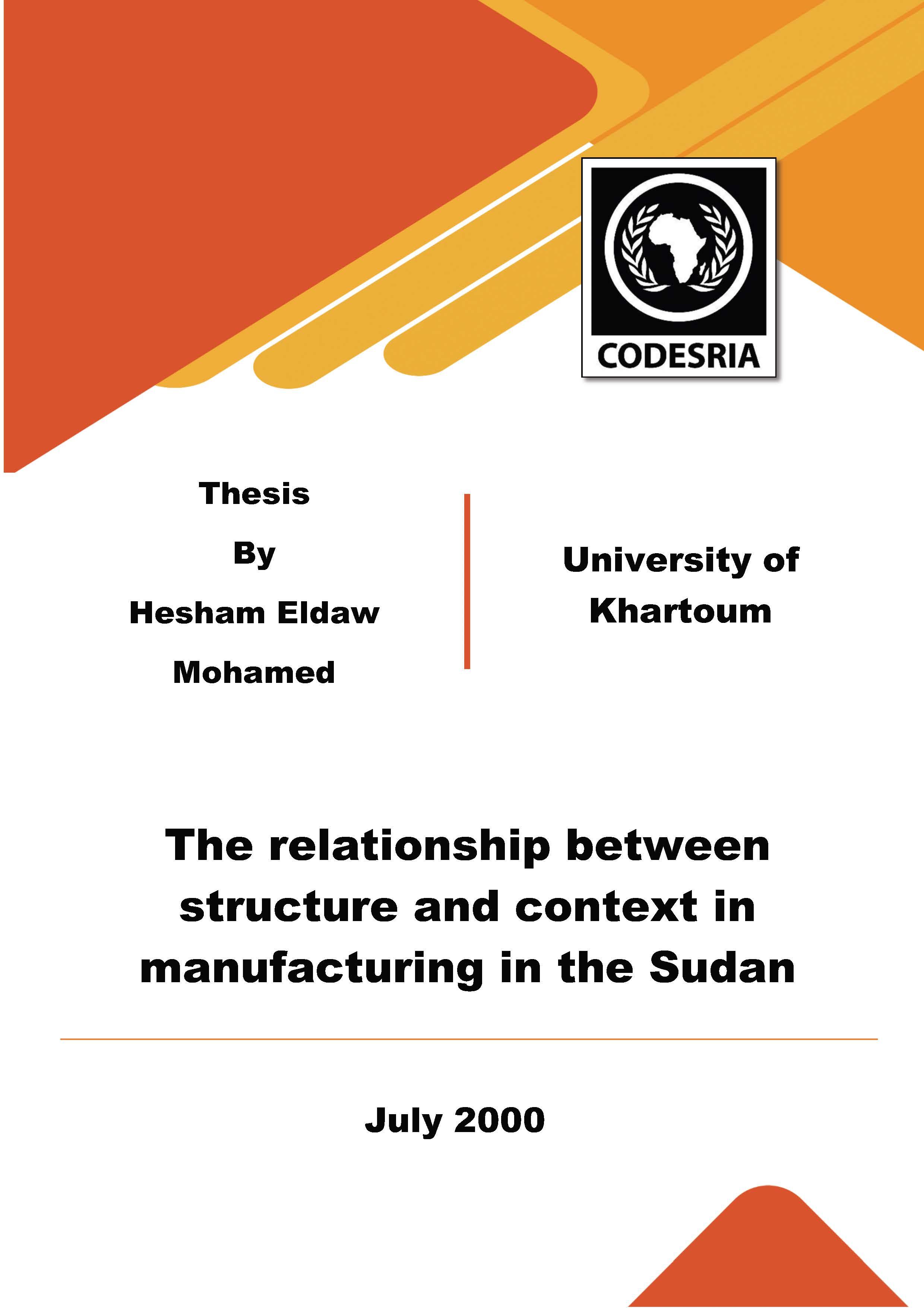The relationship between structure and context in manufacturing in the Sudan
Mots-clés :
relationship, structure, context, manufacturing, SudanSynopsis
The Relationship between Structure and Context in Manufacturing in the Sudan.
Based on the on-going debate among organization scholars on the relationship between structure and context, the primary objective of this research is to specify the relative importance of the contextual dimensions in determining structure of the manufacturing firms in Sudan with crosscultural comparisons.
The research devoted · a separate chapter to familiarize the reader with the societal level of industrialization in Sudan, which is
characterized by the domination of light industries operating at relatively low capacities. The literature review revealed that in spite of the numerous researches conducted on the relationship between context and structure, litt]e agreement was reported about the results and the nature of this relationship.
The disagreement among researchers with respect to the relationship between structure and context may be attributed to the
different "operationalizations" adopted by the researchers for the organizational dimensions under question, in addition to the variations in the sample selection and organizational levels of analysis.
Unlike the majority of the other researches using structurecontingency models to study the structural variations among
organizations on bivariate basis, this research deals with multivariate relationships by using more sophisticated statistical models. The analysis of variance (ANOVA) and the multiple analysis of variance (MANOVA) have been adopted to test the research hypotheses.
The Aston Group (1969)' s measures have been adopted to operationalize most of the research concepts, beside the attempts of the researcher to operationalize the others.
The analysis of the research findings revealed that there is sorne sort of interdependence among the contextual dimensions ( e.g. size and location, ownership and dependence) which may complicate and distort the research results. Sorne of the structural variables seem to reflect the same organizational aspect although they are treated distinctly in the analysis. The analysis has shown that "size" is the rnost important determinant of organizational structure in the Sudan followed by ownership and control. The other contextual dimensions -including technology- have not shown any significance vis-a-viz the overall structure even thought they have some bearing on sorne of the structural variables on an individual basis.
Cross-cultural comparisons have been made between the results of this research and the results of similar researches conducted in the Western milieu. In spi te of the differences between the Sudan and those Western countries, similar results have been obtained with respect to the relationship between st1ucture and context. This may suggest that the "culture bound" organizational behaviour 1s not as strong as it is perceived by man y researchers. Globalization, transfer of technology, training and education of the Sudanese decision-makers in the Western countries help to minimize the impact of culture upon management practices in Sudan.
The research has suggested a structure-contingency model that shows the contextual pressures and their impact on the structure on an overall basis and the individual structural variables constrained by the perception ofthe decision-makers.
Suggestions have also been made to expedite the research in this area by conducting longitudinal studies to investigate the causal effect of different organizational dimensions including performance. More cross-cultural studies have to be conducted, using similar methodology to settle the on-going debate on the "universality" and "culture-bound" organizational behaviour. All this should be done in the framework of building and establishing a sound "organization theory".
Téléchargements
Références
Bank of Sudan: Annual Reports 1981/82/86/89/92/93.
Ministry of Finance and economics (1962): The Ten Year Plan of economic and Social Development of the Sudan 1961/62-1970/71 ( Government Printing Press , Khartoum).
Ministry of National Planning (1977): The Six Ye!lf Plan of Economie and Social Development 1977/78-1972/73( Khartoum).
Ministry oflndustry(1990): Report on the Performanc~ of the Ministry of Industry (Cabinet ofMinisters, Sudan)
Abdel Hameed, K. A. (1974): Enterprise - Industrial Enterpreneurship in Development ( SAGE publication L TD, London)
Abdel Salam, Mohamed M. (1997): "Agriculture m the Sudan" in Ali Mohamed El Hassan ( ed.) An Introduction to the Sudan economy ( Khartoum, Khartoum University Press 1977).
Abu Affan .Bodour O. (1985): Industrial Policies and Industrialization in The Sudan ( Khartoum Graduate College Publications No.16, University of Khartoum )
Adrich, Howard E. (1972): "Technology and Organization Structure: A Reexamination of the Findings of the Aston Group" in Administrative Science Quarterly Vol. 17: 26-41.
Ali, Abbas H. (1988): The Impact ofNational Cultures and Interpersonal Factors on Managerial Communication (Unpublished Ph.D Thesis, University of Birmingham).
Amber, G. H. and P. S. Amber (1962): Anatomy of Automation (Englewood Cliffs, Prentice-Hall).
Barnard, I. Chester ( 1938): "The Theory of Authority" in Patrick E.Conner (ed.), Dimension in Modern Management, (U.S.A, Houghton Mifflin Company 1974).






